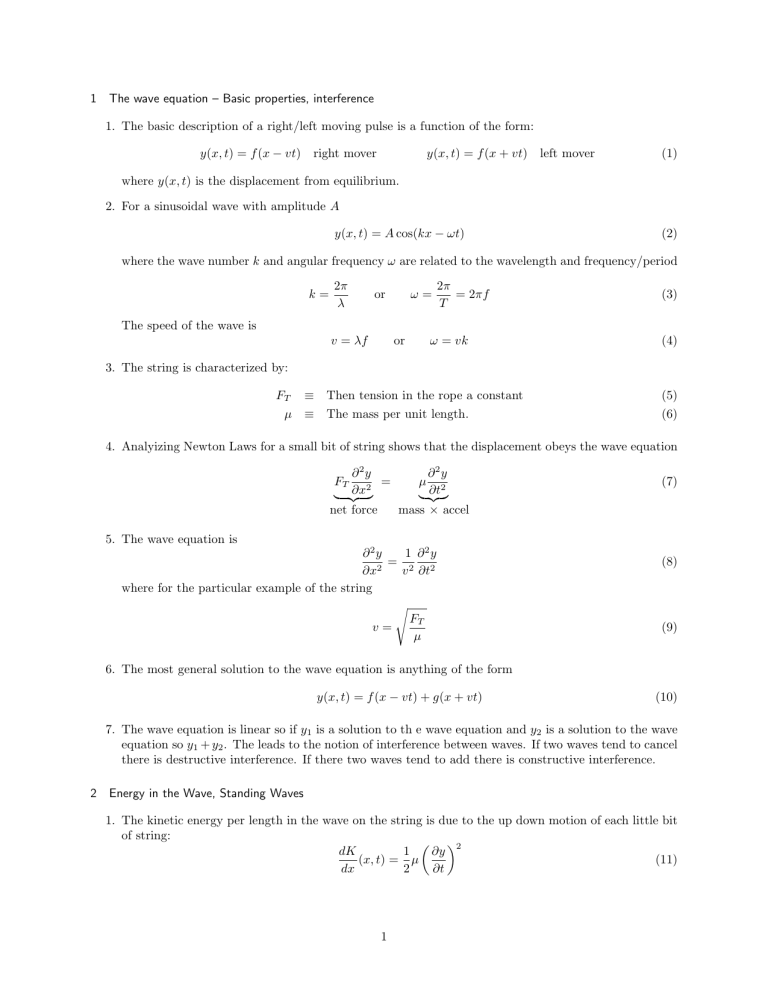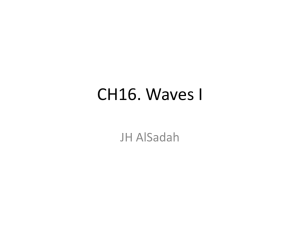1 The wave equation – Basic properties, interference 1. The basic

1 The wave equation – Basic properties, interference
1. The basic description of a right/left moving pulse is a function of the form: y ( x, t ) = f ( x − vt ) right mover y ( x, t ) = f ( x + vt ) left mover (1) where y ( x, t ) is the displacement from equilibrium.
2. For a sinusoidal wave with amplitude A y ( x, t ) = A cos( kx − ωt ) (2) where the wave number k and angular frequency ω are related to the wavelength and frequency/period k =
2 π
λ or ω =
2 π
T
= 2 πf (3)
The speed of the wave is v = λf or ω = vk (4)
3. The string is characterized by:
F
T
≡ Then tension in the rope a constant
µ ≡ The mass per unit length.
(5)
(6)
4. Analyizing Newton Laws for a small bit of string shows that the displacement obeys the wave equation
∂ 2 y
F
T
∂x 2
| {z } net force
= µ
∂ 2 y
∂t 2
| {z } mass × accel
(7)
5. The wave equation is
∂ 2 y
∂x 2
=
1 ∂ 2 y v 2 ∂t 2 where for the particular example of the string v = s
F
T
µ
(8)
(9)
6. The most general solution to the wave equation is anything of the form y ( x, t ) = f ( x − vt ) + g ( x + vt ) (10)
7. The wave equation is linear so if y
1 is a solution to th e wave equation and y
2 is a solution to the wave equation so y
1
+ y
2
. The leads to the notion of interference between waves. If two waves tend to cancel there is destructive interference. If there two waves tend to add there is constructive interference.
2 Energy in the Wave, Standing Waves
1. The kinetic energy per length in the wave on the string is due to the up down motion of each little bit of string:
2 dK
( x, t ) = dx
1
2
µ
∂y
∂t
(11)
1
Figure 1: Standing waves from bottom n = 1 to top n = 4
2. The potential energy per length on the string is due to the stretching of the string. For small oscillations we have:
2 dU dx
( x, t ) =
F
T
2
∂y
∂x
(12)
3. The total energy per length is the sum of the kinetic and potential energies
2 u
E
( x, t ) =
1
2
µ
∂y
∂t
2
+
F
T
2
∂y
∂x
(13)
4. The power or the energy transmitted per unit time from left to right (at position x and time t ) is
P ( x, t ) = − F
T
∂y
∂x
∂y
∂t
(14)
5. (Sinusoidal waves only) When considering sinusoidal waves with frequency ω one finds that at fixed point x one finds that the kinetic energy oscillates in time as sin
2
( kx − ωt ). Usually one is not interested in these rapid oscillations and one cares only time averaged kinetic energy. We will denote these time averages with an overbar. We showed in class that since sin
2
+ cos 2 = 1 we have sin
2
( kx − ω = cos 2 ( kx − ω ) =
1
2
(15)
6. (Sinusoidal waves only) The average kinetic energy, equals the average potential energy dK dx
= dU dx
=
1
4
µA
2
ω
2
You should be able to show this.
7. (Sinusoidal waves only) The average energy per length and average power transmitted are u
E
=
1
2
µA
2
ω
2
P = u
E v
Can you show that u
E
= F
T
A 2 k 2 / 2
(16)
(17)
3 Standing Waves
1. For standing waves on the string we have the following wavelengths based on the figure below.
L = n
λ n
2 n = 1 , 2 , 3 , 4 , . . .
The corresponding frequencies are f n
= nf
1 where v f
1
=
2 L
(18)
(19)
2
2. The equation describing the standing waves on the string is a sum of a right moving and a left moving wave y stand
= A sin( k n x − ω n t ) + A sin( k n x + ω n t )
= 2 A sin( k n x ) cos( ω n t )
(20)
(21) where k n
= 2 π/λ n
. You should feel comfortable with the sequence of steps going from line 1 to line 2
4 Transmission and Reflection
1. When a wave is refected from a fixed end, it is reflectecd returns inverted. When it returns from a free end (and end which can move) it is reflected by returns un-inverted.
2. When a wave transverses from a string of mass density µ
R it is partially transmitted and partially reflected. The wavelengths ( λ
L
, λ
R
), and velocities ( v
L
, v
R
) are not the same on both sides, but the tension and frequencies are.
and crosses to mass density µ
R
µ
L
, k
L
, λ
L
, v
L
µ
R
, k
R
, λ
R
, v
R
Tension and frequency are constant
3. The wave on the left hand side is a sum of the incident wave (with amplitude A ) and a reflected wave
(with amplitude B ) y
L
= A cos( k
L x − ωt ) + B cos( k
L x + ωt ) (22)
The transmitted wave (with amplitude C ) is y
R
= C cos( k
R x − ωt )
By demanding that the string not be broken or have any kinks at the joining point for all time
(23) y
L
( x, t ) | x =0
= y
R
( x, t ) | x =0
∂y
L
∂x x =0
=
∂y
R
∂x x =0
We determined
B = A
C = A k
L
− k
R k
L
+ k
R
2 k
L k
L
+ k
R
You should be able to quickly show that
B = A
C = A
√
√
√
µ
L
−
µ
L
+
√
µ
2
L
√
µ
R
√
µ
R
µ
L
+
√
µ
R
(24)
(25)
(26)
(27)
3




